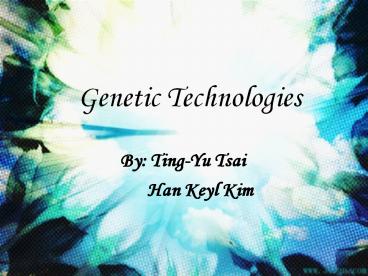Genetic Technologies - PowerPoint PPT Presentation
1 / 13
Title:
Genetic Technologies
Description:
Genetic Technologies By: Ting-Yu Tsai Han Keyl Kim 19.1 Patenting DNA Biotechnology -Use or alteration of cells or biological molecules for specific applications. – PowerPoint PPT presentation
Number of Views:39
Avg rating:3.0/5.0
Title: Genetic Technologies
1
Genetic Technologies
- By Ting-Yu Tsai
- Han Keyl Kim
2
19.1 Patenting DNA
- Biotechnology
- -Use or alteration of cells or biological
molecules for specific applications. - Organisms that harbor DNA from other species are
termed Transgenic and their DNA is called
recombinant DNA
3
The OncoMouse or Harvard mouse is a type of
laboratory mouse that has been genetically
modified using modifications designed by Philip
Leder and Timothy A. Stewart of Harvard
University to carry a specific gene called an
activated oncogene. The activated oncogene
significantly increases the mouses
susceptibility to cancer, and thus makes the
mouse suitable for cancer research. The rights to
the invention are owned by DuPont. OncoMouse(R)
is a registered trademark.
Patented OncoMouse
The Laboratory, or The Passion of OncoMouse
4
Key Concept
- Biotechnology is the use of modification of cells
or biological molecules for a specific
application. - Patent law regarding DNA has evolved with the
technology since the 1970s, and is still changing.
5
19.2 Amplifying DNA PCR
- Polymerase Chain Reaction (PCR) are the
technologies for amplified DNA that invented by
Kary Mullis in 1983. He then won the Nobel prize
for PCR in 1993. - Use of PCR
- - DNA cloning for sequencing
- - DNA-based phylogeny
- - Diagnosis of hereditary diseases
- - Functional analysis of genes
- - Identification of genetic fingerprints
- - Detection and diagnosis of infectious
diseases
6
PCR STEPS
- Initialization Heating the reaction to 94-96C.
Its only required for DNA polymerases. - Denaturation First regular cycling. Heat for
separate 2 strands of the target DNA. - Annealing 2 short primers and Taq1 DNA
polymerase added. Cool to allow primers form
hydrogen bond with ends of target sequence. - Extension DNA polymerase adds nucleotides to the
3 end of each primer. - Final elongation This step is to ensure that
any remaining single-stranded DNA is fully
extended. - Final hold May be employed for short-term
storage of the reaction.
7
19.3 Modifying DNA
- Modifying DNA
- -Researchers thought about uses and risks of
mixing DNA from different species. - -Recombinant DNA technology was safer than
expected, and the technology has spread to
industry more swiftly and in more diverse ways.
8
Cloning vectors
- Plasmid
- Bacteriophage
- Bacterial artificial
- Chromosome (BAC)
- Yeast artificial
- Chromosome (YAC)
Size of insert accepted up to 15
Size of insert accepted up to 90
Size of insert accepted 100 to 500
Size of insert accepted up to 15
9
- Genomic library a population of host bacteria,
each of which carries a DNA molecule that was
inserted into a cloning vector, such that the
collection of cloned DNA molecules represents the
entire genome of the source organism. This term
also represents the collection of all of the
vector molecules, each carrying a piece of the
chromosomal DNA of the organism, prior to the
insertion of these molecules into the host cells.
- DNA probe a single-stranded DNA molecule used in
laboratory experiments to detect the presence of
a complementary sequence among a mixture of other
singled-stranded DNA molecules. - cDNA library is a collection of cloned cDNA
(complementary DNA) fragments inserted into a
collection of host cells, which together
constitute some portion of the transcriptome of
the organism. cDNA is produced from fully
transcribed mRNA found in the nucleus and
therefore contains only the expressed genes of an
organism. Similarly, tissue specific cDNA
libraries can be produced. In eukaryotic cells
the mature mRNA is already spliced, hence the
cDNA produced lacks introns and can be readily
expressed in a bacterial cell. While information
in cDNA libraries is a powerful and useful tool
since gene products are easily identified, the
libraries lack information about enhancers,
introns, and other regulatory elements found in a
genomic DNA library.
10
Transgenic Plants
- Transgenic plants are easier to create than
transgenic animals because plants can be derived
from somatic cells. - Protoplasts The denude plant cells had their
cell walls removed by some manipulations.
- Protoplasts
11
Ti Plasmid
- Ti plasmid is a circular plasmid that is a part
of the genetic equipments that Agrobacterium
tumefaciens use to transduce its genetic material
to plants. It normally causes a tumor-like
growth.
- Producing a transgenic plant
12
Bacillus Thuringiensis
- Bt is a soil-dwelling bacterium that commonly
used as a pesticide. - When bt gene is bring into corn cells via a Ti
plasmid, the cells regenerate corn plants and
produce their own insecticide. - Possible problems The pollen form Bt maize could
kill the monarch butterfly.
13
References
- http//en.wikipedia.org/wiki/Polymerase_chain_reac
tion - Chapter 19 Genetic Technologies, Human Genetics
8th Edition, McGraw-Hill Companies, Ricki Lewis,
2008. - http//www.everythingbio.com/
- http//scienceblogs.com/insolence/2007/06/the_auti
sm_omnibus_the_difference_betwee.php - http//www.biology.lsu.edu/webfac/nkato/methods/me
thodImages/Protoplast.jpg - http//www.mun.ca/biology/desmid/brian/BIOL2060/BI
OL2060-20/2032.jpg - http//en.wikipedia.org/wiki/Bacillus_thuringiensi
s































